I have a huge affinity for native fruiting plants and have covered many Dianella species thus far but Dianella caerulea, in particular, is widely considered one of the most ornamental of its genus and it is also one of the most commonly grown bush tuckers of its genus as it produces shiny edible indigo-coloured berries that are some of the tastiest on offer.
It sports splendid bright-green strappy blade-like foliage and delicately soft-blue blooms from spring to summer. This gorgeous specimen is now a very popular suburban plant as it adapts readily to cultivation and is perfect for all growers regardless of skill level.
I’ve compiled this in-depth grow and care guide for this beloved Dianella species to make your experience cultivating the plant in your garden as straightforward and prolific as possible. Let’s get started.
Family: | Asphodelaceae |
|---|---|
Genus: | Dianella |
Species: | D. caerulea |
Common Names: | Paroo lily, blue flax-lily |
Location: | Outdoor |
Type: | Clumping perennial, native flowering plant |
Growth: | 0.5 to 1 metre tall and wide |
Sun requirements: | Full sun to part shade |
Foliage Colour: | Green |
Flower Colour: | Blue |
Flowering: | Spring to summer |
Fruit: | Produces edible indigo berries after flowering in autumn |
Maintenance level: | Low |
Poisonous for pets: | Toxic to cats and dogs |
Getting to Know Dianella caerulea
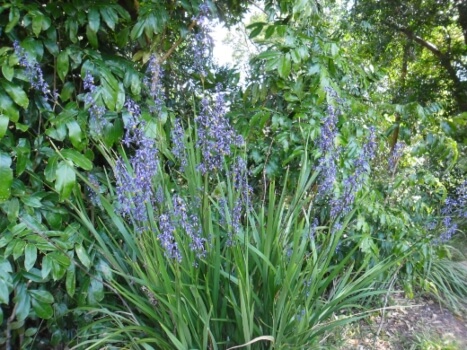
Source: ppnn.org.au
A truly all-around stunner, this plant produces attractive foliage, flowers and fruits all encompassed by a relaxed and practical form for landscape gardening.
The strappy, grass-like leaves can reach up to 75cm in length and the petite star-shaped blue blooms are borne in sprays on gently branching panicles with decorative orange-yellow anthers from spring to summer.
This very hardy, long-lived plant features a compact and dense growth habit, making it the perfect fit for any garden, regardless of size or setting. If you’re looking for a highly attractive native fruiting plant that won’t require much hassle, this is the plant for you.
Blue Flax Lily Plant Details
Botanically labelled Dianella caerulea, this plant’s common names include the Paroo lily and the blue flax-lily. It is a native that occurs throughout the eastern regions of Australia in Victoria, New South Wales, Queensland and Tasmania.
It is very well adapted to our endemic climates so it can be grown in most Australian gardens without concern. This plant is one of about 40 species in the Dianella genus.
Part of the Asphodelaceae family, this perennial herb is considered slow-growing in most situations. It will usually grow to about 1 metre tall and wide in gardens so it can offer a multitude of landscaping applications as well.
This species will fruit from year 1 or 2 onwards depending on the growing conditions and the fruits will naturally attract local birds and butterflies to your garden.
Dianella caerulea vs Dianella cevoluta
The Dianella revoluta species produces very similar berries that can be used in the same way as the Dianella caerulea berries. The fruits look almost identical but D. caerulea produces larger, more indigo-coloured berries whereas D. revoluta produces smaller, more blueish-purple berries.
Luckily, the berries from Dianella caerulea are said to be the tastiest of the genus so you’re not missing out on more appetising harvests.
Common Blue Flax Lily Landscaping Applications
- Poolside planting
- Gap-filling
- General shrubbery
- Ground cover
- Border planting
- Perfect for pots or planters
- Understory planting
- Mass planting
- Accent or feature plant
- Coastal gardening
- Planting in rockeries – Our gardening with rocks guide can be found here.
It is important to note that not all Dianella species produce berries that are safe for human consumption. I cover this in more detail in the bush tucker section of the article.
Popular Dianella caerulea Cultivars
Dianella caerulea ‘Little Jess’Considered one of the best-selling Dianella cultivars, this plant, as its name suggests, is a smaller-growing variety that has been widely cultivated successfully for over a decade. It is a dwarf cultivar with a clumping growth habit, growing up to about 40cm tall and wide. It features masses of purple flowers in summer and broader bright-green leaves than other varieties. It is the perfect pick for container gardening or smaller spaces. | 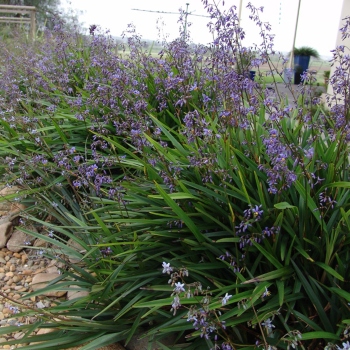 Source: gardenexpress.com.au |
Dianella caerulea ‘King Alfred’This cultivar features foliage with more blue-green in its hues. It is also a compact and dense grower that remains tidy without any pruning. The blooms are borne in sprays of purple and yellow from spring and this plant is considered extremely hardy. This variety grows to around 70cm tall and wide, making it a great pick for any garden or situation. It is considered the best cultivar for erosion control, reportedly strengthening soil by up to 750%. |  Source: alpinenurseries.com.au |
Dianella caerulea ‘Emerald Fountain’This super versatile variety is perfect for more shaded gardens and it can be grown in almost any location or climate. It also produces pretty purple flowers atop bright-green arching foliage with a gently weeping habit. Growing to around 40cm tall and wide, this cultivar is perfect for smaller gardens in mass plantings, understory plantings or rockeries and borders. | 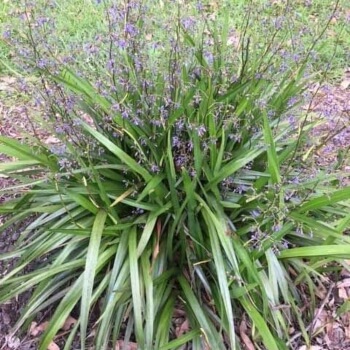 Source: australianplantsonline.com.au |
Dianella caerulea ‘Breeze’This is a very tidy, no-cane variety that is renowned as a tough ground cover plant. Unlike other dianellas that produce tall, messy canes, this cultivar remains neat and compact without any assistance. This plant is fast-growing, reaching about 60 to 70 centimetres tall and wide. It produces delicate blue and yellow blooms in spring and has more upright foliage. It is also a great pick for erosion control as the rhizomes spread very evenly in the soil. This variety is a great gap filler in beds. | 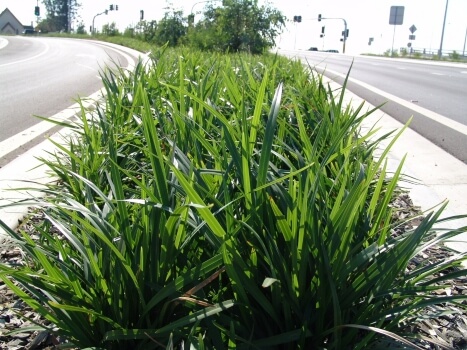 Source: gardeningwithangus.com.au |
Dianella caerulea ‘Little Jess’

Source: gardenexpress.com.au


Get Your Free Guide:
Master Growing Australian Natives eBook
A Must Have Complete Guide for Every Australian Garden
Get Your Free Guide:
Master Growing Australian Natives eBook
A Must Have Complete Guide for Every Australian Garden
Considered one of the best-selling Dianella cultivars, this plant, as its name suggests, is a smaller-growing variety that has been widely cultivated successfully for over a decade. It is a dwarf cultivar with a clumping growth habit, growing up to about 40cm tall and wide.
It features masses of purple flowers in summer and broader bright-green leaves than other varieties. It is the perfect pick for container gardening or smaller spaces.
Dianella caerulea ‘King Alfred’

Source: alpinenurseries.com.au
This cultivar features foliage with more blue-green in its hues. It is also a compact and dense grower that remains tidy without any pruning. The blooms are borne in sprays of purple and yellow from spring and this plant is considered extremely hardy.
This variety grows to around 70cm tall and wide, making it a great pick for any garden or situation. It is considered the best cultivar for erosion control, reportedly strengthening soil by up to 750%.
Dianella caerulea ‘Emerald Fountain’

Source: australianplantsonline.com.au
This super versatile variety is perfect for more shaded gardens and it can be grown in almost any location or climate. It also produces pretty purple flowers atop bright-green arching foliage with a gently weeping habit.
Growing to around 40cm tall and wide, this cultivar is perfect for smaller gardens in mass plantings, understory plantings or rockeries and borders.
Dianella caerulea ‘Breeze’

Source: gardeningwithangus.com.au
This is a very tidy, no-cane variety that is renowned as a tough ground cover plant. Unlike other dianellas that produce tall, messy canes, this cultivar remains neat and compact without any assistance.
This plant is fast-growing, reaching about 60 to 70 centimetres tall and wide. It produces delicate blue and yellow blooms in spring and has more upright foliage. It is also a great pick for erosion control as the rhizomes spread very evenly in the soil. This variety is a great gap filler in beds.
How to Grow Dianella caerulea
This plant responds very well to propagation. The thick, spreading underground rhizomes can easily be divided to create new plants or you can also use seeds collected from ripe fruits to grow new plants.
Basic Conditions for Planting Dianella caerulea
This hardy Dianella species can tolerate a wide range of growing conditions. It is known to stabilise sand very well and it should ideally be sheltered from strong winds to avoid damage. Planting should be done in spring to early summer.
Ideal Soil for Paroo Lily
Dianella caerulea is tolerant to many soil types including sandy, loamy, sandy-loam or clay-loam soils. It can withstand some extra moisture but the soil needs to be well-draining for the best results.
The soil pH level should be acidic to neutral and the soil should also be moderately fertile. Check your soil’s pH level with this 4-in-1 Soil pH Meter available online.
Exposure Needs for Blue Flax-Lily
This plant grows best in full sun to partially shaded positions. Though it can tolerate full shade, blooms and fruiting will most likely be compromised in these locations. Aim for around 6 hours of decent sun exposure on most days and your plant should thrive.
Propagating Blue Flax Lily
Propagation of any kind should start in late summer to autumn once temperatures have cooled slightly and the plant is done flowering and fruiting.
Alternatively, your local nurseries or garden centres should readily stock young and healthy plants that can quickly be transplanted and established in your garden should you not be too keen on the propagation process.
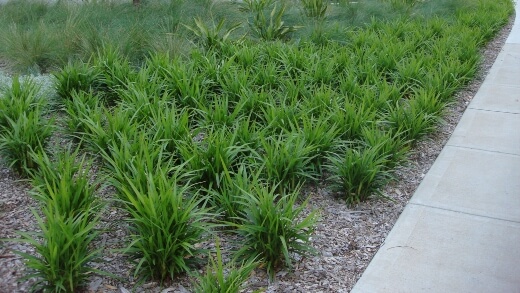
Source: plantswhitsunday.com.au
Propagating Paroo Lily by Division of Rhizomes
Large clumps of established dianellas can be gently dug up and divided to reduce congestion and to create new plants.
- Use a sharp and sterilised spade or shovel and gently lift the rhizomes of the parent plant from the ground so you have a good view.
- Using a swift and precise motion, cut the rhizomes as needed to divide the plant into about 2 to 3 clumps depending on its size.
- Prepare your planting hole or container and dig some compost into the soil.
- Gently place the newly divided plant into the desired position and backfill with soil until the rhizomes are snug and secure.
- Water lightly after planting and keep the soil moist while the new plants establish new roots and growth.
Growing Blue Flax-Lily from Seed
Collect healthy seeds from berries once they have softened and turned fully indigo from green. When the berries are squishy, you’ll know the seeds are ready for growth. Each berry should contain a few black seeds that you can extract and use.
- Prepare seed trays or propagation containers filled with a high-quality seed-raising mix or potting mix. (See this speciality seed raising mix for propagation as a reference).
- Gently sow the seeds into the top of the mix and only lightly cover them with soil. Some of the seeds should still be visible.
- Water or mist lightly after sowing and place the seeds in a warm, sheltered location away from bright, direct light and cold drafts of any kind.
- Ideal temperatures for germination are between 13 and 18°C.
- Only water when the soil starts drying out to avoid rot.
- Seeds usually strike in only a few weeks. Once they have germinated, allow seedlings to develop indoors throughout winter before attempting to transplant them into larger containers or the garden.
- Consider only transplanting the next season during spring in the plant’s most active period.
Caring for Dianella caerulea
Being one of the hardier in its genus, the care requirements for the Paroo lily are quite basic versus other fruiting and flowering plants. Once established, this plant is tolerant to drought, frost and snow.
Again, this indicates that it can be grown in almost any Australian garden without major concerns.

Source: candide.com
Pruning Paroo Lily
Dianellas are known to be quite fuss-free when it comes to pruning. Lightly cut back at the base of the plant as needed to keep it tidy and maintain your desired size. These plants are known to resprout readily.
In late autumn after fruiting, it is best to also prune away old flower spikes and any dead or yellowed foliage. This will also help to ensure proper air circulation each season which can help in preventing any mould or disease issues.
Refer to our guide on pruning different types of Australian native plants for more info.
How to Water Dianella caerulea
Being quite tolerant to drought, this plant can withstand a little neglect here. In its developmental stages, water regularly and deeply allowing only the topsoil to dry between waterings.
After about a year, the plant will be mostly established. Cut back on watering at this stage as natural rainfall should be sufficient. Water supplementary as needed, especially during fruiting and flowering.
Fertilising Dianellas
Feed your plant with high-quality native plant food every 6 months, especially after flowering. Be sure to prolong harvest slightly after fertilising and water well after feeding to avoid possible contaminated berries.
If you notice the leaves beginning to yellow, this should indicate that you’re adding too much fertiliser.
Dianella caerulea Bush Tucker Guide
In late summer to early autumn after flowering, this plant will produce decorative, shiny indigo-coloured berries that are safe for human consumption, in moderation. Each berry can be as big as 1.2cm in diameter when fully ripe.
The berries contain tiny black nutty seeds in them. The entirety of these round and fleshy fruits (flesh and seeds) can be consumed and are said to be very palatable with a sweet and nutty flavour profile.

Source: plantsinabox.com.au
Exercising Caution
There are only 3 or 4 species of Dianella (out of around 40) that produce fruits safe for human consumption. Dianella caerulea (Paroo lily) is known to be one of the safest and tastiest in the genus.
As with all bush food, it is always best to exercise some moderation with the frequency and quantity of consumption.
Be sure you have the right plant as there are a few known toxic species which include:
- D. tasmanica
- D. intermedia
- D. nigra
Harvesting Blue Flax-Lily Berries
If you have recently fertilised, be sure to delay harvests slightly.
- Once the berries have softened and turned from green to indigo or royal blue, they will be ready for harvest. This will be after flowering in late summer to autumn.
- You can simply pick off ripe berries straight from the branches of the plant.
- Some newly ripened berries may also have recently fallen around the base of the plant that can also be collected if you wish.
How to Use Dianella caerulea Berries
- These tasty berries are suitable for eating in moderation when ripe.
- Be sure to always rinse the berries before use or storage.
- The berries can be enjoyed fresh or cooked into sweet or savoury dishes to add a deliciously fruity and nutty flavour profile.
- Many enjoy cooking them into other condiments like jams, jellies and marinades.
- They can also be used in baked foods like muffins or cakes.
- The plant root can be pounded, roasted and enjoyed as well.
- There is unfortunately little reported information on the nutritional content of these berries but they have been enjoyed by Aboriginal people as well as European settlers for generations.
If you prefer storing some of your harvests, the berries can be safely stored in the fridge for up to 2 weeks and in the freezer for up to 2 years. There are many tasty recipes available online for these berries so be sure to get creative and enjoy your lovely bush tucker in all its glory.
If you’re interested in knowing more about our spectacular bush tucker plants and trees, be sure to check out our extensive bush tucker catalogue here for more information.
Dianella caerulea Pests, Problems and Diseases
Being one of the hardiest in its genus, this plant isn’t known to struggle with many issues of note in most situations. Here are a few issues you may run into on rare occasions:
Mealybugs
These small pests appear as tiny white to light-grey insects with purplish insides. They also produce a cotton-like wax coating in large numbers. Treat with organic neem oil or an organic insecticidal soap or spray.
Mites/Aphids/Scale Insects
These pests appear as small reddish-brown spots on foliage and roots. They can be controlled using organic neem oil or by spraying the plant with an organic insecticide or similar horticultural oil mixed with water.
Flax Lily Rust
This rare fungal disease usually attacks coastal-grown dianellas. It will appear as an orange rusty residue on leaves and stems. To treat this disease, cut down your plant to around 15cm above the ground and apply a copper-based fungicidal spray every few weeks.
Water well after each treatment and your plant should hopefully bounce back.
Dianella caerulea Frequently Asked Questions
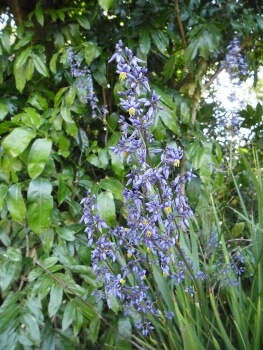
Source: ppnn.org.au
Are dianellas invasive?
Some species do produce extensive underground rhizomes that can become invasive. D. ensifolia is considered an invasive species in some regions but Dianella caerulea is not considered invasive, especially when grown in gardens.
Does Dianella caerulea need full sun?
This plant is particularly encouraged to grow prolifically in full sun positions. Usually, the more shade it gets, the slower its growth and the less bountiful the blooms and fruits become.
How often do you water flax lilies?
It is recommended to water when the top 2.5 to 5 centimetres of soil has become dry. This should avoid any overwatering issues.
Why is my Dianella caerulea dying?
These plants can die back after a hard freeze. Once temperatures have started to warm, cut back the plant from the base and it should start to resprout when the active season begins.
Indulge Your Native Landscaping Desires with the Decorated Dianella caerulea
With its ability to produce fabulous foliage, flowers and fruits, it’s no wonder Dianella caerulea has become such a stand-out in its entire genus. Offering growers so much, not only in terms of natively beautifying their gardens, but also with its tasty, decorative berries, this plant will certainly always impress.
It’s easy to enjoy the lusciously-leaved foliage, dainty blue blooms and attractive fruits with this spectacular native flowering plant. Start growing your very own Dianella caerulea today and see why this plant is adored by so many across the country.
Published on October 22, 2022 by Lorri Hopkins
Last Updated on September 19, 2025




